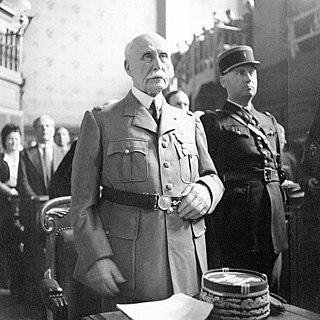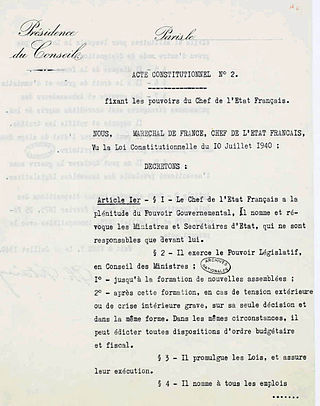
Henri Philippe Bénoni Omer Joseph Pétain, better known as Philippe Pétain and Marshal Pétain, was a French general who commanded the French Army in World War I and later became the head of the collaborationist regime of Vichy France, from 1940 to 1944, during World War II.

Free France was a resistance government claiming to be the legitimate government of France following the dissolution of the Third Republic during World War II. Led by General Charles de Gaulle, Free France was established as a government-in-exile in London in June 1940 after the Fall of France to Nazi Germany. It joined the Allied nations in fighting Axis forces with the Free French Forces, supported the resistance in Nazi-occupied France, known as the French Forces of the Interior, and gained strategic footholds in several French colonies in Africa.

The French Fourth Republic was the republican government of France from 27 October 1946 to 4 October 1958, governed by the fourth republican constitution of 13 October 1946. Essentially a reestablishment and continuation of the French Third Republic which governed from 1870 during the Franco-Prussian War to 1940 during World War II, it suffered many of the same problems which led to its end. The French Fourth Republic was a parliamentary republic.

Jacques-Maurice Couve de Murville was a French diplomat and politician who was Minister of Foreign Affairs from 1958 to 1968 and Prime Minister from 1968 to 1969 under the presidency of General de Gaulle. As foreign minister he played the leading role in the critical Franco-German treaty of cooperation in 1963, he laid the foundation for the Paris-Bonn axis that was central in building a united Europe.

The Provisional Government of the French Republic was the provisional government of Free France between 3 June 1944 and 27 October 1946, following the liberation of continental France after Operations Overlord and Dragoon, and lasting until the establishment of the French Fourth Republic. Its establishment marked the official restoration and re-establishment of a provisional French Republic, assuring continuity with the defunct French Third Republic.

The épuration légale was the wave of official trials that followed the Liberation of France and the fall of the Vichy regime. The trials were largely conducted from 1944 to 1949, with subsequent legal action continuing for decades afterward.
Tripartisme was the mode of government in France from 1944 to 1947, when the country was ruled by a three-party alliance of communists, socialists and Christian democrats, represented by the French Communist Party (PCF), the French Section of the Workers' International (SFIO) and the Popular Republican Movement (MRP), respectively. The official charter of tripartisme was signed on 23 January 1946, following the resignation of Charles de Gaulle, who opposed the draft of the constitution. The draft envisioned a parliamentary system, whereas de Gaulle favored a presidential system.

Legislative elections were held in France on 21 October 1945 to elect a Constituent Assembly to draft a constitution for a Fourth French Republic. A total of 522 seats were elected through proportional representation; women were allowed to vote for the first time.

Gaston Monnerville was a French Radical politician and lawyer who served as the first President of the Senate under the Fifth Republic from 1958 to 1968. He previously served as President of the Council of the Republic from 1947 to 1958. A member of the French Resistance in World War II, he is the first black person to preside over a national parliamentary body in French history.
The French State, popularly known as Vichy France, as led by Marshal Philippe Pétain after the Fall of France in 1940 before Nazi Germany, was quickly recognized by the Allies, as well as by the Soviet Union, until 30 June 1941 and Operation Barbarossa. However, France broke with the United Kingdom after the destruction of the French Fleet at Mers-el-Kebir. Canada maintained diplomatic relations until the occupation of Southern France by Germany and Italy in November 1942.

The French Committee of National Liberation was a provisional government of Free France formed by the French generals Henri Giraud and Charles de Gaulle to provide united leadership, organize and coordinate the campaign to liberate France from Nazi Germany during World War II. The committee was formed on 3 June 1943 and after a period of joint leadership, on 9 November it came under the chairmanship of de Gaulle. The committee directly challenged the legitimacy of the Vichy regime and unified all the French forces that fought against the Nazis and collaborators. The committee functioned as a provisional government for Algeria and the liberated parts of the colonial empire. Later it evolved into the Provisional Government of the French Republic, under the premiership of Charles de Gaulle.

Vichy France, officially the French State, was a French rump state headed by Marshal Philippe Pétain during World War II, established after the French capitulation after the defeat against Germany. It was named after its seat of government, the city of Vichy. Officially independent, but with half of its territory occupied under the harsh terms of the 1940 armistice with Nazi Germany, it adopted a policy of collaboration. Though Paris was nominally its capital, the government established itself in the resort town of Vichy in the unoccupied "free zone", where it remained responsible for the civil administration of France as well as its colonies. The occupation of France by Germany at first affected only the northern and western portions of the country. In November 1942, the Allies occupied the French North Africa, and in response the Germans and Italians occupied the entire Metropolitan France, ending any pretence of independence by the Vichy government.

The French Constitutional Law of 1940 is a set of bills that were voted into law on 10 July 1940 by the National Assembly, which comprised both the Senate and the Chamber of Deputies during the French Third Republic. The law established the Vichy regime and passed with 569 votes to 80, with 20 abstentions. The group of 80 parliamentarians who voted against it are known as the Vichy 80. The law gave all the government powers to Philippe Pétain, and further authorized him to take all necessary measures to write a new constitution. Pétain interpreted this as de facto suspending the French Constitutional Laws of 1875 which established the Third Republic, even though the law did not explicitly suspend it, but only granted him the power to write a new constitution. The next day, by Act No 2, Pétain defined his powers and abrogated all the laws of the Third Republic that were incompatible with them.

The Government of Vichy France was the collaborationist ruling regime or government in Nazi-occupied France during the Second World War. Of contested legitimacy, it was headquartered in the town of Vichy in occupied France, but it initially took shape in Paris under Marshal Philippe Pétain as the successor to the French Third Republic in June 1940. The government remained in Vichy for four years, but fled to Germany in September 1944 after the Allied invasion of France. It operated as a government-in-exile until April 1945, when the Sigmaringen enclave was taken by Free French forces. Pétain was brought back to France, by then under control of the Provisional French Republic, and put on trial for treason.

The Empire Defense Council was a deliberative body established within Free France in 1940. It was subsequently replaced by the French National Committee.

The liberation of France in the Second World War was accomplished through diplomacy, politics and the combined military efforts of the Allied Powers, Free French forces in London and Africa, as well as the French Resistance.

André Diethelm was a French Resistance fighter and politician. As an Inspector General of Finance, he joined General de Gaulle and Free France during the Second World War, and presided over the Rally of the French People political party under the Fourth Republic.
The Provisional Consultative Assembly was a governmental organ of Free France that operated under the aegis of the French Committee of National Liberation (CFLN) and that represented the resistance movements, political parties, and territories that were engaged against Germany in the Second World War alongside the Allies.
The Ordinance of 9 August 1944 was a constitutional law enacted by the Provisional Government of the French Republic (GPRF) during the Liberation of France which re-established republican rule of law in mainland France after four years of occupation by Nazi Germany and control by the collaborationist Vichy regime.
The Tréveneuc Law was a law passed in the early days of the French Third Republic which established a legal framework by which the country could invoke a state of emergency in order to oppose a power grab by a rogue chief executive who illegitimately dissolved the National Assembly.














